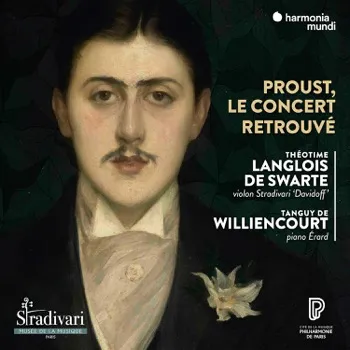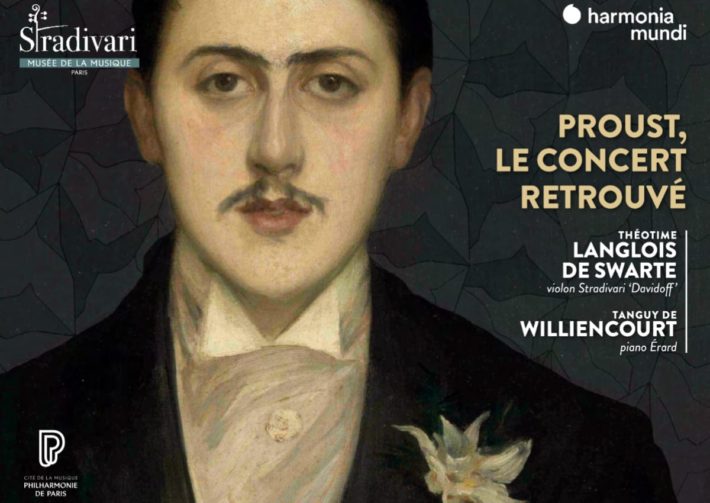This program draws upon a salon concert organized by writer Marcel Proust in 1907. Although the selections are not exactly the same as what was presented, they are a close reflection of the music the writer (as well as music enthusiasts in his social circle) appreciated – a range of eras that spanned from Baroque (Couperin) to Romantic (Chopin and Liszt), to modern (Hahn).

One composer that features heavily is Gabriel Fauré: He had long been an associate and significant inspiration for Proust and what would eventually become his most famous output – the 7-volume “In Search of Lost Time.” Violinist Théotime Langlois de Swarte performs with the 1708 “Davidoff”’ Stradivarius from what is considered the finest era of the maker’s production. Pianist Tanguy de Williencourt plays on an 1891 Érard grand piano, whose defining features include its novel double-escapement action and its size, designed for a more intimate salon space.
Des Abends from the Op. 12 Fantasiestucke (track 2) moves at a leisurely pace that allows our ears to wander peacefully through Schumann’s various textures. On occasion, the middle and lower registers of the piano, when not controlled quite enough by the performer, overpower the delicate melody. I also felt that there could be more attention paid to the composer’s striking harmonic movement between sections, which might in turn bring out a greater multi-dimensionality. If we’re looking for comparisons, Paderewski’s interpretation from his 1911-1912 recording sessions is wonderful. It offers a more varied perspective with nuanced shifts that are sensitive to the colors and moods.
Chopin’s Raindrop Prelude (track 3) not only has a more successful balance of voices, but here Williencourt really brings out the full range of the Érard. The major sections are warm and mellow; the minor ones are realistically stormy with the instrument’s surprisingly resonant bass. The only issue is that while the bel canto lines of the D-flat major sections can benefit from a reasonable degree of rubato, there is a little too much, too often. This regretfully drags the tempo, given an otherwise lovely performance.
Gabriel Fauré’s Op. 13 Violin Sonata is delightfully presented and also displays the sophistication of the instruments themselves. We can quickly perceive the beauty in the sound of the Davidoff Stradivarius. It sounds husky and velvety when played gently; even at its most impassioned, its tone remains silky. The Allegro Molto (track 4) captures Fauré’s free-spirited late Romanticism: the violin’s rhapsodic lines are well-balanced with the piano’s flowing accompaniment. The Andante that follows is a tad on the brisk side – I would have preferred a slower tempo that could more effectively bring out the lugubriousness, especially through the piano’s steadfast ‘heartbeat’. The performance nonetheless evokes a poignant sadness, thanks to minute gradations of piano and pianissimo from the violin. Although there is a distinct change of mood from the Allegro Molto, the duo is still mindful to maintain continuity. The major section is filled with an effusive yearning that echoes back to the opening movement.
Two distinct personalities are at play in the third movement, a Scherzo with a trio built in. The fast sections are playful and bubbly and show the duo’s excellent clarity and synchronicity of articulation. The F-sharp minor trio, lyrical and nostalgic, is a fitting complement to effervescent outlying sections. The Finale, with an inviting melody that we can almost sing with, is a charming sendoff.
L’heure exquise by Venezuelan-born French composer Reynaldo Hahn (with whom Proust had a close relationship) is an excellent conclusion to the album. Originally for voice and piano, it is presented here as a transcription. de Swarte’s finesse transforms the original vocal line into a lullaby that transports us into the lyrics’ tranquil, moonlit night. Even in the quietest moments, there are hints of magic that make this performance breathtaking.
The sound engineers at Harmonia Mundi do a top-notch job: balance calibration, particularly in the duo works, is flawless and brings out the best of each instrument. The liner notes aptly integrate and explain the album’s selections in the context of Proust’s relationships to the presented composers; there’s also an informative introduction to the Érard and Stradivarius. A few minor issues aside, the performance faithfully lets us experience a salon concert during the Belle Époque era. Warmly recommended.
“Proust, Le Concert Retrouvé“
Théotime Langlois De Swarte – Violin
Tanguy De Williencourt – Piano
Harmonia Mundi, CD HMM 902508




















